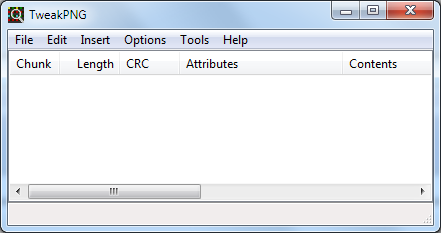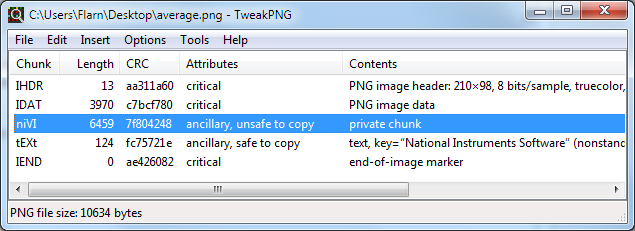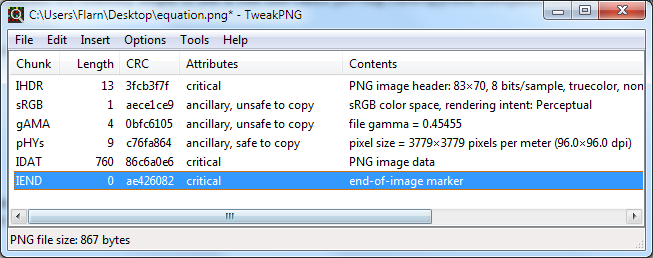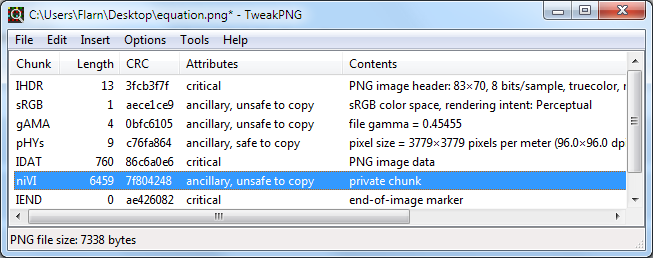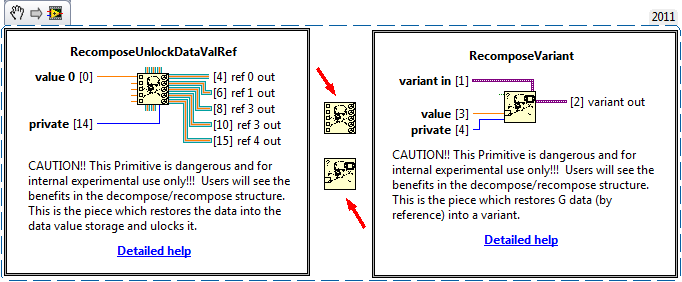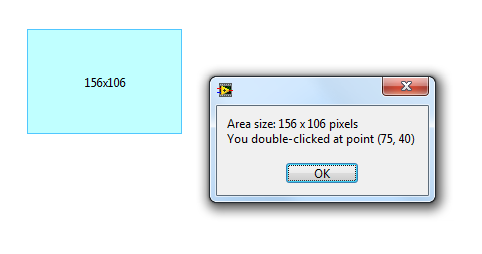-
Posts
399 -
Joined
-
Last visited
-
Days Won
29
Content Type
Profiles
Forums
Downloads
Gallery
Everything posted by Sparkette
-

What exactly is SuperSecretPrivateSpecialStuff for?
Sparkette replied to Sparkette's topic in LabVIEW General
App.Get Active VI Ref? That one could be useful, Darren. -
I made another XNode that should greatly help with selecting coordinates. Place the XNode, which is resizable, and you can click anywhere to select a point. It will then output that point's coordinates as a cluster of two I32 values. If you right-click on it, you will get a menu where you can see the selected coordinates, or replace it with a standard cluster for if you want to distribute your VI without the XNode. Point Selector Constant.zip
-
On this LabVIEW Wiki page, the following text can be found: I aim to show that this is not true. While most programs will remove the code if the image is altered, it's relatively simple to use a free tool called TweakPNG to put any VI into any PNG image. First, download TweakPNG. Now, create a VI Snippet of whatever you want. I'll be using this as an example: Run TweakPNG, and you'll see the following: Next, open your VI Snippet in TweakPNG. Select the item that's selected in that screenshot ("niVI") and then go to Edit->Export Chunk. Save the file wherever you want; you'll need it later. Next, open whatever image you want to put the VI into in TweakPNG. I'll be using this image: You'll see the following: Once again, click the item I selected ("IEND"), but now go to Edit->Import Chunk. Remember the file you saved earlier? Select that. You'll see this: Finally, go to File->Save in TweakPNG (or File->Save As if you don't want to overwrite the original image) and you'll now have a VI Snippet with a custom image. Don't believe me? Here, save this image and drag it into LabVIEW: I'm not encouraging anyone to make anything malicious as mentioned in the wiki article, but this does have legitimate uses. For instance, you may want to add some extra text to a VI Snippet explaining something, but don't want it to appear when it's dragged into LabVIEW. Or you may want to scale the image down a bit so it will fit somewhere on a web page. I'm sure there are many other uses.
-

Create your own Generic VI (like Randomize 1D Array)
Sparkette replied to Sparkette's topic in LabVIEW General
Is this functionality in the release version of LabVIEW, just not enabled? I mean, like is there any way a hacker could configure the UI like this just by modifying a few bytes or something? EDIT: Yes it is! LabVIEW.ini, "GenericsAreGo=True" -
There doesn't seem to be any introduction explaining what this thread is. Is it about objects only placeable via the New VI Object node? Because if so, I made a thread pointing out two of these. http://lavag.org/top...composevariant/
-
Does anybody know what these are for? It mentions in the context help that they're for internal experimental use only, and can only be placed via scripting (New VI Object). I'm just kind of surprised that if they are so dangerous (they say "warning: dangerous!" in the style enum list, and they even have skulls on them) that NI would even enable them to be used at all. Not that I don't think they should; it's just not like them. Are these always in the New VI Object Style list, or is it just because I have "SuperSecretPrivateSpecialStuff=True" in my LabVIEW.ini? BTW, I tried Googling the names of these primitives, and all I got was a thread on this forum containing a list of everything in that Style list.
-

Create your own Generic VI (like Randomize 1D Array)
Sparkette replied to Sparkette's topic in LabVIEW General
Lol, this is turning into the original discussion about Randomize 1D Array. But yeah, I didn't realize that rounded to the nearest integer. I had always thought it just rounded toward 0. I would use , but I would like a universal solution that would work for negative numbers too, even though negative numbers wouldn't come up in that case. I could have it set up so it rounds up if a number is negative, or down if positive (using a case structure or the ever-useful ) but that seems too complicated for a task as simple as generating a random integer between two values—surely there must be a simpler way? -
Maybe he's talking about employment by companies other than NI. While NI most likely wouldn't hire someone who breaks their EULA, other companies (especially competitors) would likely have no reason to care. EDIT: My 69th post.
-
This is my first XNode. You can place it on the block diagram, resize it, and it displays its size in pixels. If you double-click on it, it also shows the local coordinates of your double-click. It can be useful if you need some help visualizing coordinates when writing code for things like scripting front panel editing and image manipulation. Coordinate Helper XNode.zip
-

Create your own Generic VI (like Randomize 1D Array)
Sparkette replied to Sparkette's topic in LabVIEW General
Oh yes, that makes sense. And Index Array works the same on an empty array regardless of what index is given, right? Even a negative number? It just gives the default value for the array? -
Oh, so are you not allowed to post the VI?
-
Wow, really? Care to post the VI's? It's a museum after all; I doubt you'd be under an NDA. And I thought that laser harp was still there; at least it was in 2009.
-
I saw this at the Maryland Science Center in Baltimore and I just had to take a picture of it. I only thought to post it just now.
-

Create your own Generic VI (like Randomize 1D Array)
Sparkette replied to Sparkette's topic in LabVIEW General
Aristos Queue mentioned to me that Generic VI's will no longer work in LV2012. It's a shame they couldn't have changed it so it was more stable, but I guess since it's unreleased they don't really have any obligation to. But as consolation (actually just for fun), here's another Generic VI I made that takes a random choice from an array. Random Choice from Array.vi EDIT: Actually that has a glitch where it will sometimes give the default value. This is no fault of the generic VI system; I simply forgot to add a on the blue wire between the and the . But when I tried it afterwards, LabVIEW crashed, which shouldn't come as much of a surprise. But it's a simple enough fix. -

Create your own Generic VI (like Randomize 1D Array)
Sparkette replied to Sparkette's topic in LabVIEW General
Could you post a screenshot of the menu or whatever else it is you use to customize that? It's not like it would give us access to any features NI doesn't want us to have, just satisfy my curiosity about that kind of thing. -
An excellent tool, but why put that link in a new post? I know you knew about it before then, as I believe you got that link from me.
-
Try the following: Open LabVIEW and create a new VI Double-click on the front panel and type some text Save the VI Open the saved VI in a hex editor Search for the text you typed For some reason, the text doesn't appear. Any idea why? Are VI files compressed? If so, can I save it without compression or decompress it? Any SuperSecretPrivateSpecialStuff that can help?
-
I don't get what you're trying to say. But it did make me think of another reason NI intended it as the second pattern: because of the way the vertical wires look. Also, I just realized, I posted the wrong image at the top of my first post. I meant to put the single string wire there, not the array. But we all know what it looks like anyway.
-
As we all know, string wires look like this: Path and picture wires look the same, only teal and blue respectively. I'm just curious what all of you think; I know it doesn't matter, but what pattern do you see that wire as? I've always seen it like this: You know, as a line with many bends in it. NI probably intended it as something more like this: I know this because arrays of strings look like this: which is the same pattern extended another row. What do you see it as?
-

Create your own Generic VI (like Randomize 1D Array)
Sparkette replied to Sparkette's topic in LabVIEW General
I'd love it if someone from NI could post a few screenshots of that specially-compiled version, just out of curiosity. -

What exactly is SuperSecretPrivateSpecialStuff for?
Sparkette replied to Sparkette's topic in LabVIEW General
Any function to do the reverse? Maybe you could do some interesting things by editing that code. -

What exactly is SuperSecretPrivateSpecialStuff for?
Sparkette replied to Sparkette's topic in LabVIEW General
Well, I just took a quick look and noticed a couple, like App.Get Shell Icon of File and App.License.Get Licensed Version. Also, are there any other "security levels" of properties and methods? Right now I have access to public, scripting, and private, but are there any others? I ask because for the XNodeLib type (returned by App.XNode.Create) there are no properties or methods. -
That's certainly a shame. As I'm sure you know, I think it would be great if the LabVIEW community had access to all the same tools as NI, but I doubt that's going to happen. Sorry if I did anything you or NI didn't like (like the Generic VI thing I posted last night, which I imagine inspired this post) but I really wanted to share my findings with the community. Don't take it personally, not that I think you do; I would have done the same no matter who released it. I wish NI would share more things with the community, even if they aren't fully tested. After all, that's what alpha releases are for.
-

Create your own Generic VI (like Randomize 1D Array)
Sparkette replied to Sparkette's topic in LabVIEW General
One thing I'm still curious about is how NI makes generic VI's. Obviously the controls have to come from somewhere, so how do you make them? Is it like some kind of low-level VI editor that edits the individual data structures in the file? Also, how exactly does the compiler get confused?




